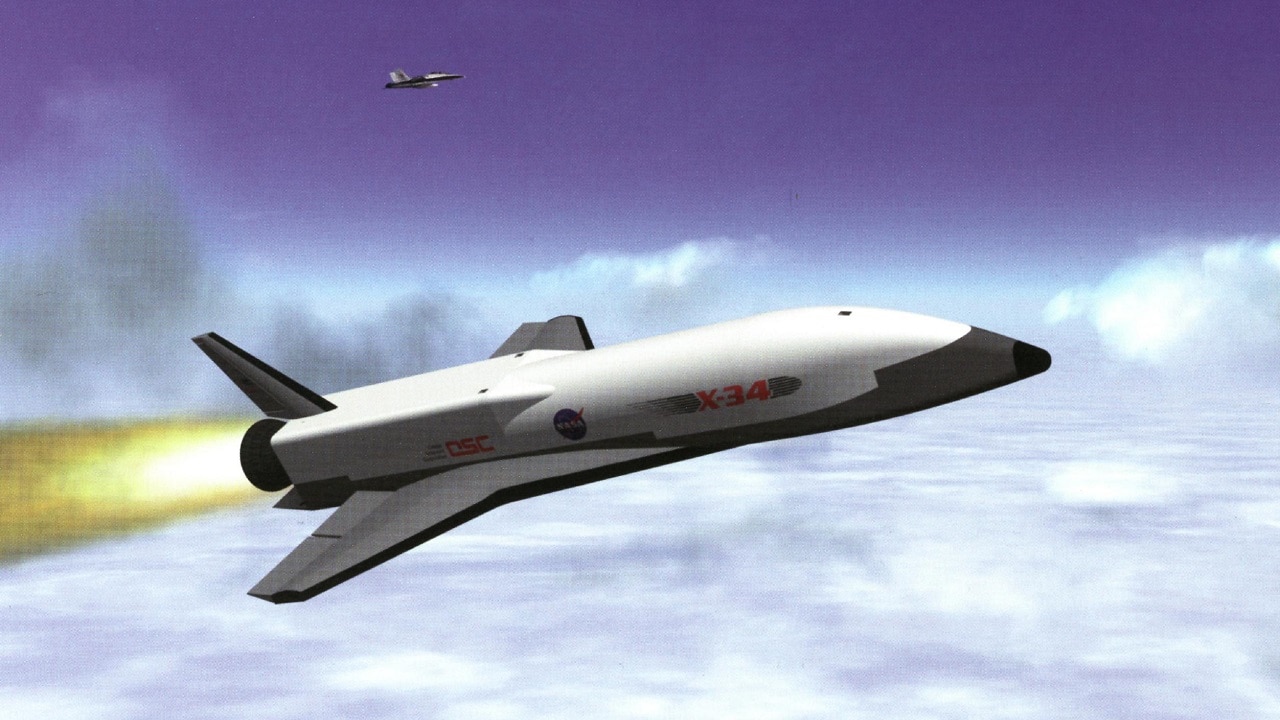By Brent M. Eastwood

X-34. Image Credit: NASA.
Before the X-37B record-setting spaceplane that can orbit the earth for years, NASA had a precursor craft that planned to accomplish cheap spaceflight with a reusability feature. Hatched in the 1990s, the X-34 was a technology demonstrator that didn’t make it to fruition, but some of its best aspects were incorporated into the X-37B.
Get Into Space Faster and Cheaper than the Space Shuttle
The program started in 1996 at NASA’s Marshall Space Flight Center. NASA wanted a craft that could reach space more frequently than the Space Shuttle. It would have a much smaller payload, but it would still be able to conduct valuable experiments in space with a quicker turnaround. Space payloads are expensive. Each payload can cost $10,000 per pound. The X-34 would have reduced that price to $1,000 a pound. Cost for each flight would be a dirt cheap $500,000 per mission.
High Speed Would Enable It to Reach Orbit
The other interesting feature of the X-34 was its speed. It was designed and intended to go MACH 8 and then reach an altitude of 50 miles. The spaceplane would orbit and then return to earth in a runway landing similar to the Space Shuttle. NASA only built two X-34 prototypes despite the lofty ambitions and innovative ideas of the program. The X-34 was 58 feet long and had a wingspan of nearly 28 feet.
It Had Some Interesting Specs
Before the X-37B record-setting spaceplane that can orbit the earth for years, NASA had a precursor craft that planned to accomplish cheap spaceflight with a reusability feature. Hatched in the 1990s, the X-34 was a technology demonstrator that didn’t make it to fruition, but some of its best aspects were incorporated into the X-37B.
Get Into Space Faster and Cheaper than the Space Shuttle
The program started in 1996 at NASA’s Marshall Space Flight Center. NASA wanted a craft that could reach space more frequently than the Space Shuttle. It would have a much smaller payload, but it would still be able to conduct valuable experiments in space with a quicker turnaround. Space payloads are expensive. Each payload can cost $10,000 per pound. The X-34 would have reduced that price to $1,000 a pound. Cost for each flight would be a dirt cheap $500,000 per mission.
High Speed Would Enable It to Reach Orbit
The other interesting feature of the X-34 was its speed. It was designed and intended to go MACH 8 and then reach an altitude of 50 miles. The spaceplane would orbit and then return to earth in a runway landing similar to the Space Shuttle. NASA only built two X-34 prototypes despite the lofty ambitions and innovative ideas of the program. The X-34 was 58 feet long and had a wingspan of nearly 28 feet.
It Had Some Interesting Specs
The unmanned X-34 had many features that were ahead of its time. It boasted GPS enabled inertial navigation system, reusable fuel tanks, thermal protection systems for bad weather, an automatic landing system, and inexpensive avionics.
It was transferred to NASA’s Dryden Flight Research Center in Edwards, California in the late 1990s. It had passed ground testing flights and was ready to be evaluated in captive carry flight. The spaceplane was carried into the air in 1999 by an Orbital Sciences Corporation Lockheed L-1011. If the captive carry tests went well, then the X-34 would have a follow on test when it would light up its pump-fed liquid fuel Fastrac rocket motor for the trip into orbit. There were two more captive carry test flights that year, but then the X-34 was grounded for good.
The original idea was to get quick feedback from the tests and take the lessons learned and integrate those features into other prototypes. Program analysts also wanted to see which type of management styles were optimum for reusable space vehicles. NASA thought it could someday make test flights every two weeks. But this never materialized.
Testing Program Had Difficulties
There were problems in the testing program. The auto-landing feature did not work correctly. The avionics were poor. By the year 2000, NASA and Orbital Sciences determined they needed to re-jigger the entire system of evaluation or cancel the program outright. They tried more ground tests and even planned to move it to White Sands Missile Range in New Mexico. Another prototype would be built and sent to Holloman Air Force Base in New Mexico as well.
Costs Became Prohibitive
But the spacecraft had enormous cost overruns and it did not appear that it would meet its milestones for the ambitious timeline. NASA believed that the X-34 was burning too much cash and it chose to stop all funding leading to its cancellation in 2001.
What Could Be Done With These Spaceplanes?
It did not end well for the X-34. It would seem that it still could have flown again or remain a technology demonstrator to train designers and engineers on unmanned flight, but that was not the case.
After cancellation the surviving platforms went on an odyssey of different Air Force and civilian installations such as Edwards Air Force Base and Mojave Air and Space Port. The existing X-34s were ignominiously housed at a residential backyard in Lancaster, California – a disappointing end for a space program that at one point showed much promise.
Expert Biography: Serving as 1945’s Defense and National Security Editor, Dr. Brent M. Eastwood is the author of Humans, Machines, and Data: Future Trends in Warfare. He is an Emerging Threats expert and former U.S. Army Infantry officer. You can follow him on Twitter @BMEastwood. He holds a Ph.D. in Political Science and Foreign Policy/ International Relations.
No comments:
Post a Comment